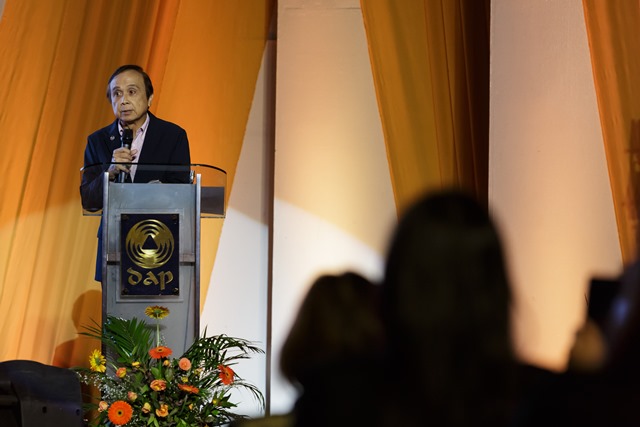
From the perspective of an economist, where is the Philippines now and where are we going? And why is it important that we know? These are just a few of the questions that Socio-Economic Planning Secretary Pernia tried to answer during the 2nd Public Management Development Program (PMDP) Leadership Conference held last September 1-2 at DAP Tagaytay attended by more than 300 executives and managers in government.
NEDA Secretary Ernesto Pernia presents the country’s economic situation during the 2nd PMDP Leadership Conference. (Photo credits: Jojo Mamangun)[/caption]
Secretary Pernia started off his presentation by reporting that the Philippines had a sharp pick-up in economic growth since Year 2010 which he credited to the past administration and went on to say that our country emerged as one of the fastest growing economy in Asia in recent years. In fact, the growth in gross domestic product (GDP), a commonly used measure of economic performance, of 7% in the 2nd quarter of 2016 is higher than what was expected. He cited the Service sector (i.e., Business Process Outsourcing (BPO), tourism) as the main driver of economic growth.
However, despite the country’s economic growth, majority of Filipinos remain in the lower socio-economic status. Secretary Pernia admitted that “…poverty reduction has been exceedingly slow. This is the nagging puzzle. The much touted fast economic growth has resulted in extremely low poverty reduction. This is the thing that we really need to address which the previous administration did not make a large enough dent on.” The Secretary provided some answers. First and foremost, he said that economic growth has not been broadly shared across socio-economic classes and regions. There is a marked imbalance in the distribution of benefits, with the mega urban industrial regions (NCR, Calabarzon, Central Luzon) taking most of the share. Agriculture, fishery, and forestry are sluggish, and that is another piece of the puzzle. There is also a significant increase in food prices, particularly rice, which pushed poverty line by almost 30% during the last 6 years. And lastly, he said, “the rapid pace of population growth with an additional of 10M has made poverty a steep challenge.”
How then do we solve a problem like poverty? The Secretary counted the ways. One is to address uneven growth or inequality by focusing efforts in developing the regional and rural areas. Another worthy endeavor would be to implement reforms in the agricultural and fishery sector. Population should also be at the center of the development plan through a full, rapid and sustained implementation of the Responsible Parenthood and Reproductive Health (RPRH Law) in the local government units. To drive home the point that population is one of the major keys to economic development, Pernia shared that in the 1970s, Thailand and the Philippines had roughly the same population and growth rate. The Philippines started implementing the family planning program and Thailand followed suit. However, our country was not able to sustain it but Thailand did. As a result, its population is now only at 67M as compared to the Philippines’ population which is 104M, with the former having a poverty incidence rate of only 11% and 26% for the latter. A smaller population would mean better health and education services which would lead to a workforce that has ample opportunities for quality employment. The Secretary said, “I’m saying that it’s not just the lack of population policy that matter but it has been a major factor.”
How can an ordinary Juan and Juana contribute to economic development? Be virtuously impatient, Secretary Pernia proposed. He said, “…don’t be too patient about the delays or having to cue up for so many things…What I’m saying is that we need to be more demanding of our officials that they should deliver service properly, correctly, and of good quality. We need some amount of impatience.”
And to the PMDP alumni, he challenged them to take on the important task of communicating to the Filipino citizens the kind of “impatience” that we all need to have. He has this to say: “DAP graduates are forward-looking, intelligent, and sharp. You can be instruments for disseminating the importance of virtuous impatience.”
The Public Management Development Program is an intensive, multi-modal training program that aims to produce a corps of public managers that embody competence, integrity and commitment. It is the Philippine government’s career executive service development program that is being overseen by a Steering Committee composed of the National Economic Development Authority, the Department of Budget and Management, the Department of Finance, the Civil Service Commission, and the Career Executive Service Board. The implementing agency of PMDP is the Development Academy of the Philippines (DAP).
PMDP is now accepting nominations for Middle Managers Class Batch 14 and 15 opening on February 17, 2017 and April 28, 2017, respectively.


